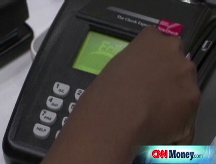More Americans insured as government steps up
Government health coverage increases, Census Bureau reports. Incomes rise slightly while poverty rate remains flat.
NEW YORK (CNNMoney.com) -- The number of Americans without health insurance decreased last year as more people signed up for government coverage, while the nation's median income rose slightly to $50,233, new government figures show.
In addition, the poverty rate remained about the same at 12.5%, with 37.3 million people living in poverty - compared with 36.5 million in 2006.
But the number of children living in poverty increased to 13.3 million, or 18%, up from 12.8 million, or 17.4%. The poverty rates for children and adults are higher than their lows of the late 1990s. And looking over the longer-term, the poverty rate experienced its largest jump during an economic recovery, increasing from 11.3% in 2001, economists said.
The data, released Tuesday by the U.S. Census Bureau, present a broad but lagging view of some key measures of the financial health of families.
Since the start of 2008, the country's economic conditions have worsened. Foreclosures, unemployment and inflation have spiked, putting a greater squeeze on many American households.
"Things are a lot worse than these numbers show," said Douglas Besharov, resident scholar at the American Enterprise Institute. "If you measured poverty today, it would probably be much higher than the report said."
As for health insurance, some 45.7 million people, or 15.3%, had no coverage, down from 47 million, or 15.8%, in 2006, as coverage by public health insurance programs grew. Some 83 million people are now enrolled in government plans, such as Medicare, Medicaid and the State Children's Health Insurance Program, up from 80.3 million in 2006.
The share of Americans with employer-based coverage fell for the seventh year in a row. It's now down to 59.3%, from 62.6% in 2001.
Median income, adjusted for inflation, rose 1.3% to $50,233, the third annual increase. Median income for black and non-Hispanic white households increased for the first time since 1999. The female-to-male earnings ratio reached an all-time high of 78%.
Still, some economists say there is little reason to cheer. The current income level is not statistically different than it was when it last peaked in 1999, the Census data shows.
"For poverty and median income, this was the worst economic expansion on record," said Robert Greenstein, executive director of the Center on Budget and Policy Priorities. "The gains from the expansion that started at the end of '01 were concentrated among higher-income Americans."
One reason why workers did so well in the previous decade is a tight labor market that forced employers to offer wage and benefit incentives to hold onto staff.
In fact, had workers continued pulling in the income increases they enjoyed in the 1990s, they would have seen a jump in earnings of $2,600 between 2001 and 2007; instead, income decreased $300, according to Jared Bernstein, senior economist at the liberal-leaning Economic Policy Institute.
"The economic recovery of the 2000s, which ended last year, has done very little to boost [workers'] living standards," Bernstein said. "They've done their part, contributing to strong productivity growth, but they've far too little to show for it." ![]()


